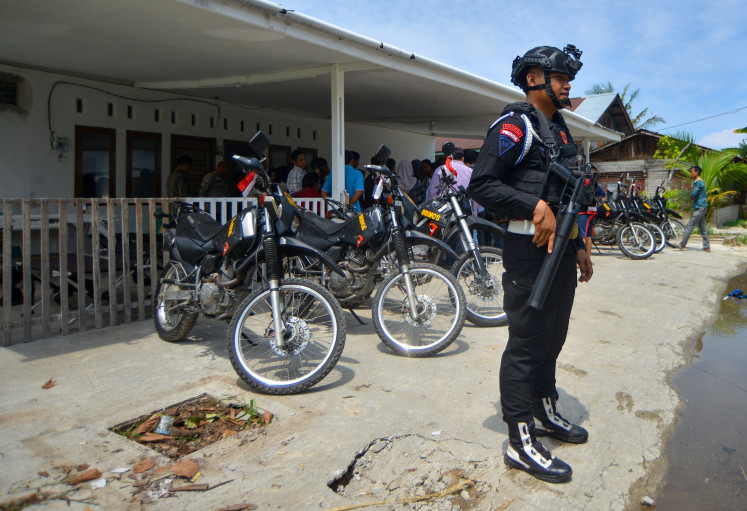Popular Reads
Top Results
Can't find what you're looking for?
View all search resultsPopular Reads
Top Results
Can't find what you're looking for?
View all search resultsIntricate details and playfulness in painting
A painting by Ida Bagus Made Widja (Batuan), Dance PerformanceMore than 100 works of art from Keliki and Batuan, two villages in Bali known for their traditional Balinese paintings, are featured in the “Keliki Miraculous, Batuan Jocularity” exhibition at Hadi Hadiprana Gallery, Jalan Kemang Raya 30, South Jakarta
Change text size
Gift Premium Articles
to Anyone
A painting by Ida Bagus Made Widja (Batuan), Dance Performance
More than 100 works of art from Keliki and Batuan, two villages in Bali known for their traditional Balinese paintings, are featured in the “Keliki Miraculous, Batuan Jocularity” exhibition at Hadi Hadiprana Gallery, Jalan Kemang Raya 30, South Jakarta.
The exhibition, running until Oct. 23, will showcase 100 unique works from Keliki and 10 paintings from Batuan. Keliki art is known for its remarkably detailed miniature paintings ranging from 5 centimeters to 30 cm. Meanwhile, Batuan art is known for its style, originating in the 1930s, and has emerged as a premier style of Balinese art.
“While Batuan paintings make us smile, Keliki works make us think. Keliki is the most amazing painting school in Bali and perhaps the country,” said Hanifah Komala, a collector, who opened the exhibition.
The exhibition is the second Keliki-Batuan exhibition in Jakarta. The first took place in 2008.
“Indonesian collectors should spend time with these extraordinary paintings. European and American art collectors and investors have been purchasing these painting for decades. French and Spanish investors frequently take home Keliki art,” collector and politician Jusuf Wanandi said during the previous exhibition.
Realizing the importance of this art, Hadiprana Gallery decided to provide a space for the exhibition.
“Since the gallery was founded in 1962, then called Prasta Pandawa, Balinese paintings have been part of our collection. So the Keliki and Batuan exhibition is a necessity,” said Hendra Hadiprana, the gallery owner, who is also an architect and an interior designer.
Paintings from Keliki began with a unique coincidence. Keliki is located in Payangan village, Ubud district, 4 kilometers north of Ubud village.
Ketut Sana, a Keliki resident, worked in Ubud, where he was acquainted with artists Gusti Nyoman Sudara Lempad and Wayan Gerudug. Ketut became interested in painting and when he returned to Keliki, he took the torn paper sheets left by Gusti and Wayan, measuring half of his hand span, on which he drew images.
Ketut’s visual horizon further expanded as he got a job at Dewata art shop in Batuan village, where he discovered Wayan Rajin’s detailed and intricate paintings, mostly small in size, similar to his initial drawings. Ketut was inspired by Rajin’s spirit, which encouraged making miniature paintings. Meanwhile, he included Ubud and Batuan styles into his work.
Ketut continued to paint and taught Keliki people how to paint, as well. By 1980, hundreds of children were painting. A school was founded and dozens of promising painters enrolled, using pens, brushes and penelak (pointed palm-leaf ribs or bamboo sticks) to smear acrylic paint and water colors on paper.
Tempo described Keliki art as created by the “hands of gods”. Keliki painters can only paint when the sun is out. “We need maximum light, which only comes from the sun,” said Wayan Nengah, a Keliki painter. Keliki artists can only work until age 40, as they are unable to handle such intricate details thereafter.
The Keliki exhibition features work by Wayan Surana, Made Ocen, Ketut Periksa, Wayan Lanus, Made Jongko, Gusti Beseg, Made Sutama, Ketut Pasek, Nyoman Cemeng among others.
The exhibition visitors have expressed frustration with the intricacy of the work, “the gallery should provide magnifying glasses so we can see the unbelievable details.”
Paintings from Batuan evoke a different story.
In Batuan, Sukawati district, Gianyar regency, since the early 20th century, traditional art has evolved, initially featuring tantrism, fables and mythology. Batuan painters prefer water colors or tempera as their medium. Ida Bagus Made Widja, Ida Bagus Made Togog, Nyoman Ngendon and Ketut Nama are well-known Batuan artists.
Their art has been studied and collected by scientists Margaret Mead and Gregory Bateson from Princeton University in the US. Part of the collection was auctioned by Christie’s in Singapore in 2001.
Batuan paintings maintain an enticing atmosphere (tenget in Balinese). In the beginning, most of paintings accentuated black and white colors known as sigar mangsi in Balinese. For additional colors, if any, only dark green and brown were applied so the paintings appeared monochromatic.
Batuan painters have adopted tourism and rituals in Bali as themes for their paintings, usually presented in a satirical fashion. The sigar mangsi tradition is being abandoned as bright colors are taking its place. Wayan Bendi, Ketut Sadia, Ni Gusti Natih Arimini, Wayan Diana and Made Griyawan are Batuan artists of the 1980s who exhibit these trends.
“Batuan art keeps us young as the paintings keep us laughing,” said a tourist visiting Bali.
— Photo by Agus Dermawan T

.img_assist_custom-511x766.jpg)








